Assessment of the Impacts of Climate and Land Use Changes on Water Yield in the Ebinur Lake Basin
Abstract
:1. Introduction
2. Materials and Methods
2.1. Study Area
2.2. InVEST Model
2.3. Data Acquisition
2.4. Model Rates
2.5. Scenario Analysis
3. Results
3.1. Temporal and Spatial Dynamics of Water Yield in the Ebinur Lake Basin
3.2. Analysis of Land Use Change Characteristics during 2000–2020
3.3. Differences in Water Yield by Land Use Type
3.4. Effects of Climate Change and Land Use Modifications on Water Yield
4. Discussion
4.1. Land Use Change and Its Water Yield Characteristics
4.2. Effects of Climate Change and Land Use on Water Yield
4.3. Limitations of the InVEST Model
5. Conclusions
Author Contributions
Funding
Data Availability Statement
Conflicts of Interest
References
- Daily, G.C. Nature’s Services: Societal Dependence on Natural Ecosystems (1977); Yale University Press: London, UK, 2013. [Google Scholar]
- Fu, B.j.; Zhou, G.Y.; Bai, Y.F.; Song, C.C.; Liu, Y.; Zhang, H.Y.; Liu, Y.H.; Zheng, H.; Xie, G.D. Progress of terrestrial ecosystem service function and ecological security geoscience in China. Adv. Earth Sci. 2009, 24, 571–576. [Google Scholar]
- Egoh, B.; Rouget, M.; Reyers, B.; Knight, A.T.; Cowling, R.M.; Van Jaarsveld, A.S.; Welz, A. Integrating ecosystem services into conservation assessments: A review. Ecol. Econ. 2007, 63, 714–721. [Google Scholar] [CrossRef]
- Reid, W.V.; Mooney, H.A.; Cropper, A.; Capistrano, D.; Carpenter, S.R.; Chopra, K.; Dasgupta, P.; Dietz, T.; Duraiappah, A.K.; Hassan, R.; et al. Ecosystems and Human Well-Being—Synthesis: A Report of the Millennium Ecosystem Assessment; Wageningen University & Research: Wageningen, The Netherlands, 2005. [Google Scholar]
- Costanza, R.; d’Arge, R.; De Groot, R.; Farber, S.; Grasso, M.; Hannon, B.; Limburg, K.; Naeem, S.; O’neill, R.V.; Paruelo, J. The value of the world’s ecosystem services and natural capital. Ecol. Econ. 1997, 387, 253–260. [Google Scholar] [CrossRef]
- Turner, K.G.; Odgaard, M.V.; Bøcher, P.K.; Dalgaard, T.; Svenning, J.-C. Bundling ecosystem services in Denmark: Trade-offs and synergies in a cultural landscape. Landsc. Urban Plan. 2014, 125, 89–104. [Google Scholar] [CrossRef]
- Zhang, W.J.; Sun, X.Y.; Zhou, J. Spatial-temporal trade-off relationship of key ecosystem services in Nansi Lake Basin. Acta Ecol. Sin. 2021, 41, 8003–8015. [Google Scholar] [CrossRef]
- Hoyer, R.; Chang, H. Assessment of freshwater ecosystem services in the Tualatin and Yamhill basins under climate change and urbanization. Appl. Geogr. 2014, 53, 402–416. [Google Scholar] [CrossRef]
- Xie, Y.C.; Gong, J.; Qi, S.; Wu, J.; Hu, B.Q. Spatial-temporal differentiation of water supply services in Bailong River Basin based on InVEST model. J. Nat. Resour. 2017, 32, 1337–1347. [Google Scholar]
- Pessacg, N.; Flaherty, S.; Brandizi, L.; Solman, S.; Pascual, M. Getting water right: A case study in water yield modelling based on precipitation data. Sci. Total Environ. 2015, 537, 225–234. [Google Scholar] [CrossRef]
- Lang, Y.; Song, W.; Deng, X. Projected land use changes impacts on water yields in the karst mountain areas of China. Phys. Chem. Earth Parts A/B/C 2018, 104, 66–75. [Google Scholar] [CrossRef]
- Yu, J.; Yuan, Y.; Nie, Y.; Ma, E.; Li, H.; Geng, X. The temporal and spatial evolution of water yield in Dali County. Sustainability 2015, 7, 6069–6085. [Google Scholar] [CrossRef]
- Legesse, D.; Vallet-Coulomb, C.; Gasse, F. Hydrological response of a catchment to climate and land use changes in Tropical Africa: Case study South Central Ethiopia. J. Hydrol. 2003, 275, 67–85. [Google Scholar] [CrossRef]
- Song, W.; Deng, X.; Yuan, Y.; Wang, Z.; Li, Z. Impacts of land-use change on valued ecosystem service in rapidly urbanized North China Plain. Ecol. Model. 2015, 318, 245–253. [Google Scholar] [CrossRef]
- Cuo, L.; Beyene, T.K.; Voisin, N.; Su, F.; Lettenmaier, D.P.; Alberti, M.; Richey, J.E. Effects of mid-twenty-first century climate and land cover change on the hydrology of the Puget Sound basin, Washington. Hydrol. Process. 2011, 25, 1729–1753. [Google Scholar] [CrossRef]
- Han, Z.; Song, W.; Deng, X.; Xu, X. Trade-offs and synergies in ecosystem service within the three-rivers headwater region, China. Water 2017, 9, 588. [Google Scholar] [CrossRef]
- Baker, T.J.; Miller, S.N. Using the Soil and Water Assessment Tool (SWAT) to assess land use impact on water resources in an East African watershed. J. Hydrol. 2013, 486, 100–111. [Google Scholar] [CrossRef]
- Yang, D.; Liu, W.; Tang, L.; Chen, L.; Li, X.; Xu, X. Estimation of water provision service for monsoon catchments of South China: Applicability of the InVEST model. Landsc. Urban Plan. 2019, 182, 133–143. [Google Scholar] [CrossRef]
- Francesconi, W.; Srinivasan, R.; Pérez-Miñana, E.; Willcock, S.P.; Quintero, M. Using the Soil and Water Assessment Tool (SWAT) to model ecosystem services: A systematic review. J. Hydrol. 2016, 535, 625–636. [Google Scholar] [CrossRef]
- Leh, M.D.; Matlock, M.D.; Cummings, E.C.; Nalley, L.L. Quantifying and mapping multiple ecosystem services change in West Africa. Agric. Ecosyst. Environ. 2013, 165, 6–18. [Google Scholar] [CrossRef]
- Yin, G.; Wang, X.; Zhang, X.; Fu, Y.; Hao, F.; Hu, Q. InVEST model-based estimation of water yield in North China and its sensitivities to climate variables. Water 2020, 12, 1692. [Google Scholar] [CrossRef]
- Marquès, M.; Bangash, R.F.; Kumar, V.; Sharp, R.; Schuhmacher, M. The impact of climate change on water provision under a low flow regime: A case study of the ecosystems services in the Francoli river basin. J. Hazard. Mater. 2013, 263, 224–232. [Google Scholar] [CrossRef] [PubMed]
- Redhead, J.; Stratford, C.; Sharps, K.; Jones, L.; Ziv, G.; Clarke, D.; Oliver, T.; Bullock, J. Empirical validation of the InVEST water yield ecosystem service model at a national scale. Sci. Total Environ. 2016, 569, 1418–1426. [Google Scholar] [CrossRef]
- Wang, Y.H.; Dai, E.F.; Ma, L. Spatiotemporal and influencing factors analysis of water yield in the Hengduan Mountain region. J. Nat. Resour. 2020, 35, 16. [Google Scholar] [CrossRef]
- Chen, S.S.; Liu, K.; Bao, Y.B. Spatial pattern and influencing factors of water conservation service function in Shangluo City. Sci. Geogr. Sin. 2016, 36, 9. [Google Scholar] [CrossRef]
- Lin, S.W.; Wu, R.D. Spatial distribution characteristics of ecosystem water supply services in ‘Three Parallel Rivers’ area. West. For. Sci. 2015, 44, 8. [Google Scholar] [CrossRef]
- Jing, T.F. Evaluation of Ecosystem Service Function of Plateau Lakes Based on InVest Model. Master’s Thesis, Yunnan Normal University, Yunnan, China, 2017. [Google Scholar]
- Wang, P. Pollution Assessment and Health Risk Assessment of Rare Earth Elements in Soil of Ebinhu Watershed. Master’s Thesis, Xinjiang University, Urumqi, China, 2021. [Google Scholar]
- Wei, Q.; Abudureheman, M.; Halike, A.; Yao, K.; Yao, L.; Tang, H.; Tuheti, B. Temporal and spatial variation analysis of habitat quality on the PLUS-InVEST model for Ebinur Lake Basin, China. Ecol. Indic. 2022, 145, 109632. [Google Scholar] [CrossRef]
- Tang, H.; Halike, A.; Yao, K.; Wei, Q.; Yao, L.; Tuheti, B.; Luo, J.; Duan, Y. Ecosystem service valuation and multi-scenario simulation in the Ebinur Lake Basin using a coupled GMOP-PLUS model. Sci. Rep. 2024, 14, 5071. [Google Scholar] [CrossRef]
- Zhang, F.; Yushanjiang, A.; Jing, Y. Assessing and predicting changes of the ecosystem service values based on land use/cover change in Ebinur Lake Wetland National Nature Reserve, Xinjiang, China. Sci. Total Environ. 2019, 656, 1133–1144. [Google Scholar] [CrossRef]
- Yushanjiang, A.; Zhang, F.; Yu, H. Quantifying the spatial correlations between landscape pattern and ecosystem service value: A case study in Ebinur Lake Basin, Xinjiang, China. Ecol. Eng. 2018, 113, 94–104. [Google Scholar] [CrossRef]
- Hou, Z.; Lv, G.; Jiang, L.J.S. Functional diversity can predict ecosystem functions better than dominant species: The case of desert plants in the Ebinur Lake Basin. Sustainability 2021, 13, 2858. [Google Scholar] [CrossRef]
- Bagstad, K.J.; Semmens, D.J.; Waage, S.; Winthrop, R.J.E.s. A comparative assessment of decision-support tools for ecosystem services quantification and valuation. Ecosyst. Serv. 2013, 5, 27–39. [Google Scholar] [CrossRef]
- Sharp, R.; Chaplin-Kramer, R.; Wood, S.; Guerry, A.; Tallis, H.; Ricketts, T.; Nelson, E.J.; Ennaanay, D.; Wolny, S.; Olwero, N.; et al. InVEST User’s Guide; The Natural Capital Project, Stanford University, University of Minnesota, The Nature Conservancy, and World Wildlife Fund: Minneapolis, MN, USA, 2018. [Google Scholar] [CrossRef]
- Vigerstol, K.L.; Aukema, J.E. A comparison of tools for modeling freshwater ecosystem services. J. Environ. Manag. 2011, 92, 2403–2409. [Google Scholar] [CrossRef]
- Canqiang, Z.; Wenhua, L.; Biao, Z.; Moucheng, L.J. Water Yield of Xitiaoxi River Basin Based on InVEST Modeling. J. Resour. Ecol. 2012, 3, 50–54. [Google Scholar] [CrossRef]
- Fu, B. On the calculation of the evaporation from land surface. Chin. J. Atmos. Sci. 1981, 5, 23. [Google Scholar]
- Zhang, L.; Dawes, W.; Walker, G. Response of mean annual evapotranspiration to vegetation changes at catchment scale. Water Resour. Res. 2001, 37, 701–708. [Google Scholar] [CrossRef]
- Sharp, R.; Tallis, H.; Ricketts, T.; Guerry, A.; Wood, S.A.; Chaplin-Kramer, R.; Nelson, E.; Ennaanay, D.; Wolny, S.; Olwero, N. InVEST User’s Guide; Academic Press: Stanford, CA, USA, 2014; Volume 306. [Google Scholar]
- Lang, Y.; Song, W.; Zhang, Y. Responses of the water-yield ecosystem service to climate and land use change in Sancha River Basin, China. Phys. Chem. Earth 2017, 101, 102–111. [Google Scholar] [CrossRef]
- Li, S.; Yang, H.; Lacayo, M.; Liu, J.; Lei, G. Impacts of land-use and land-cover changes on water yield: A case study in Jing-Jin-Ji, China. Sustainability 2018, 10, 960. [Google Scholar] [CrossRef]
- Ruan, H.; Zou, S.; Yang, D.; Wang, Y.; Yin, Z.; Lu, Z.; Li, F.; Xu, B. Runoff simulation by SWAT model using high-resolution gridded precipitation in the upper Heihe River Basin, Northeastern Tibetan Plateau. Water 2017, 9, 866. [Google Scholar] [CrossRef]
- Jiang, Y.; Shao, M.A. Effects of soil structural properties on saturated hydraulic conductivity under different land-use types. Soil Res. 2014, 52, 340–348. [Google Scholar] [CrossRef]
- McQueen, D.; Shepherd, T. Physical changes and compaction sensitivity of a fine-textured, poorly drained soil (Typic Endoaquept) under varying durations of cropping, Manawatu Region, New Zealand. Soil Tillage Res. 2002, 63, 93–107. [Google Scholar] [CrossRef]
- Wahl, N.A.; Bens, O.; Schäfer, B.; Hüttl, R. Impact of changes in land-use management on soil hydraulic properties: Hydraulic conductivity, water repellency and water retention. Phys. Chem. Earth Parts A/B/C 2003, 28, 1377–1387. [Google Scholar] [CrossRef]
- Lian, X.H.; Qi, Y.; Wang, H.W.; Zhang, J.L.; Yang, R. Assessing Changes of Water Yield in Qinghai LAKE Watershed of China. Water 2019, 12, 11. [Google Scholar] [CrossRef]
- Li, Z.; Liu, W.; Zhang, X.; Zheng, F. Impacts of land use change and climate variability on hydrology in an agricultural catchment on the Loess Plateau of China. J. Hydrol. 2009, 377, 35–42. [Google Scholar] [CrossRef]
- Stone, M.C. Impacts of climate change on missouri rwer basin water yield. JAWRA J. Am. Water Resour. Assoc. 2001, 37, 1119–1129. [Google Scholar] [CrossRef]
- Mcfarlane, D.; Stone, R.; Martens, S.; Thomas, J.; Silberstein, R.; Ali, R.; Hodgson, G. Climate change impacts on water yields and demands in south-western Australia. J. Hydrol. 2012, 475, 488–498. [Google Scholar] [CrossRef]
- Smith, P.; House, J.I.; Bustamante, M.; Sobocká, J.; Harper, R.; Pan, G.; West, P.C.; Clark, J.M.; Adhya, T.; Rumpel, C. Global change pressures on soils from land use and management. Glob. Chang. Biol. 2016, 22, 1008–1028. [Google Scholar] [CrossRef]
- Biro, K.; Pradhan, B.; Buchroithner, M.; Makeschin, F. Land use/land cover change analysis and its impact on soil properties in the northern part of Gadarif region, Sudan. Land Degrad. Dev. 2013, 24, 90–102. [Google Scholar] [CrossRef]
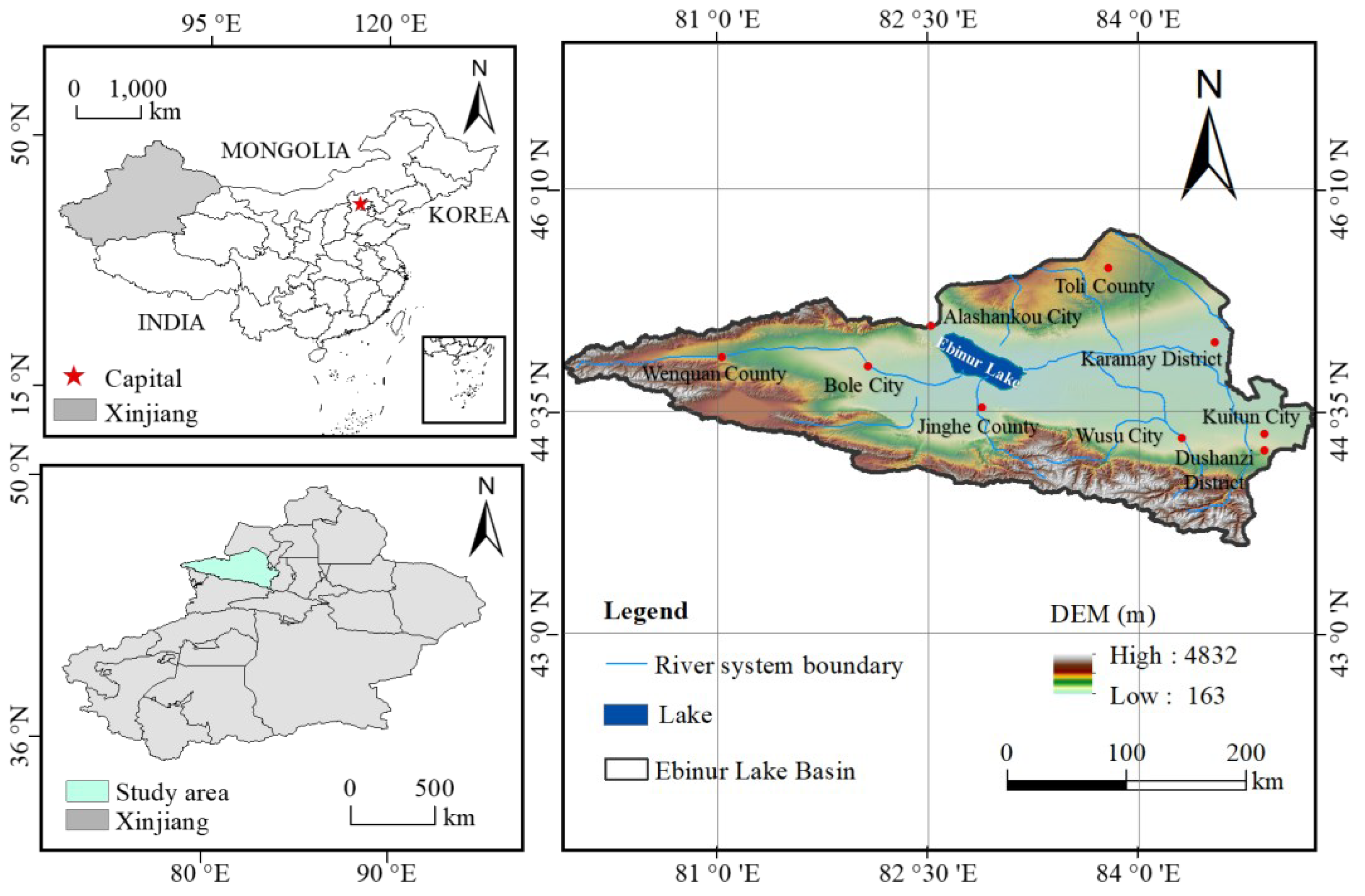
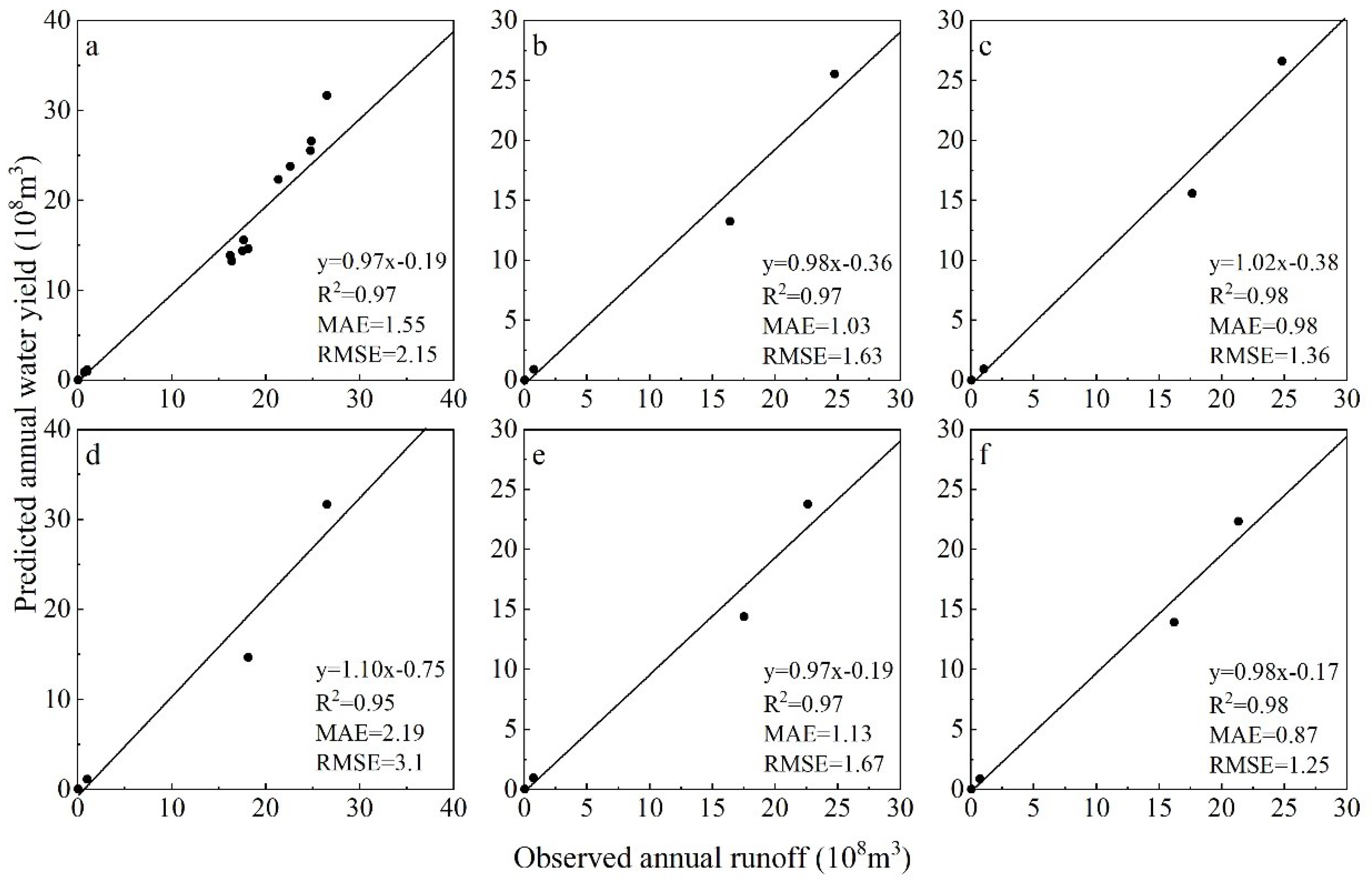
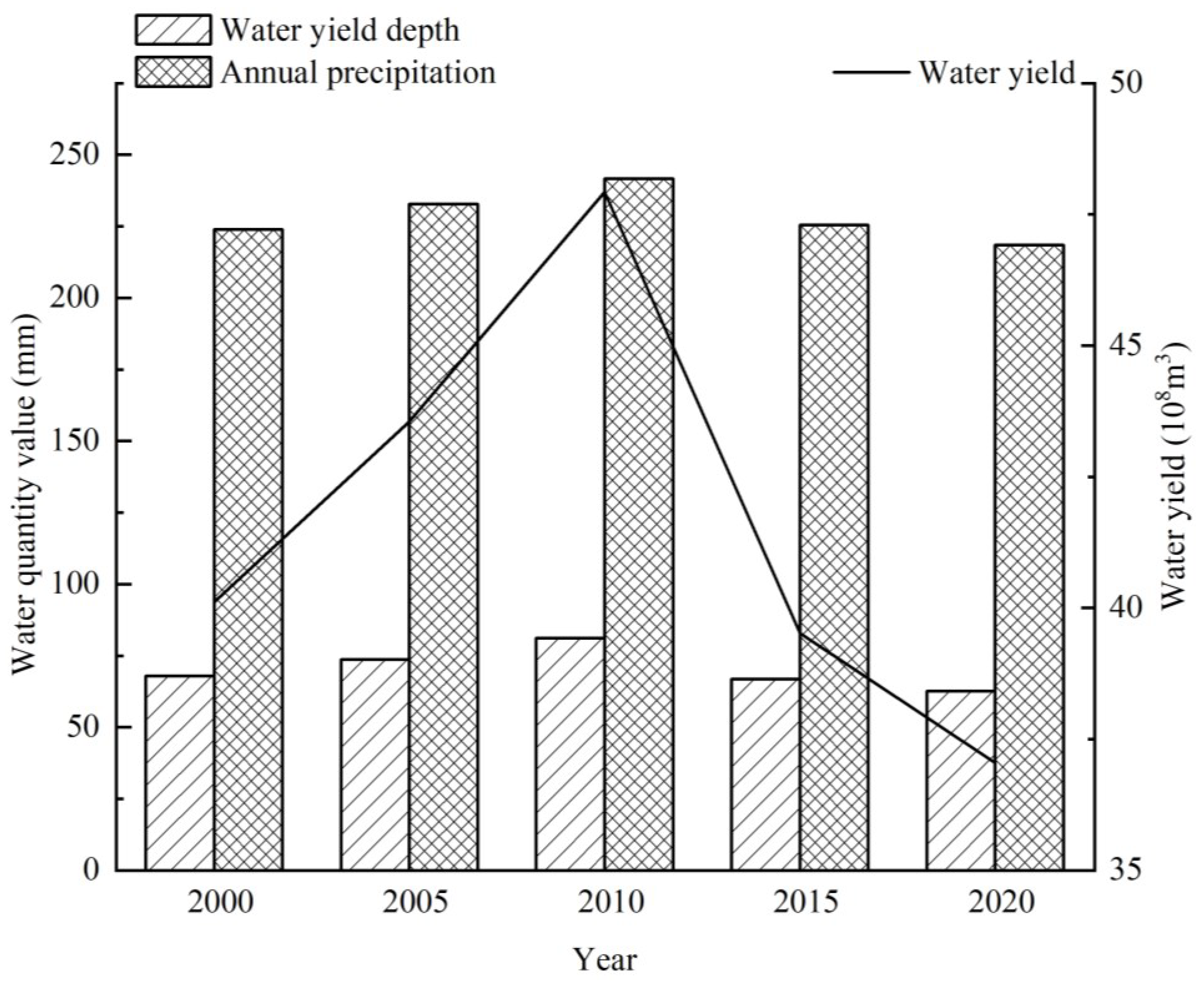
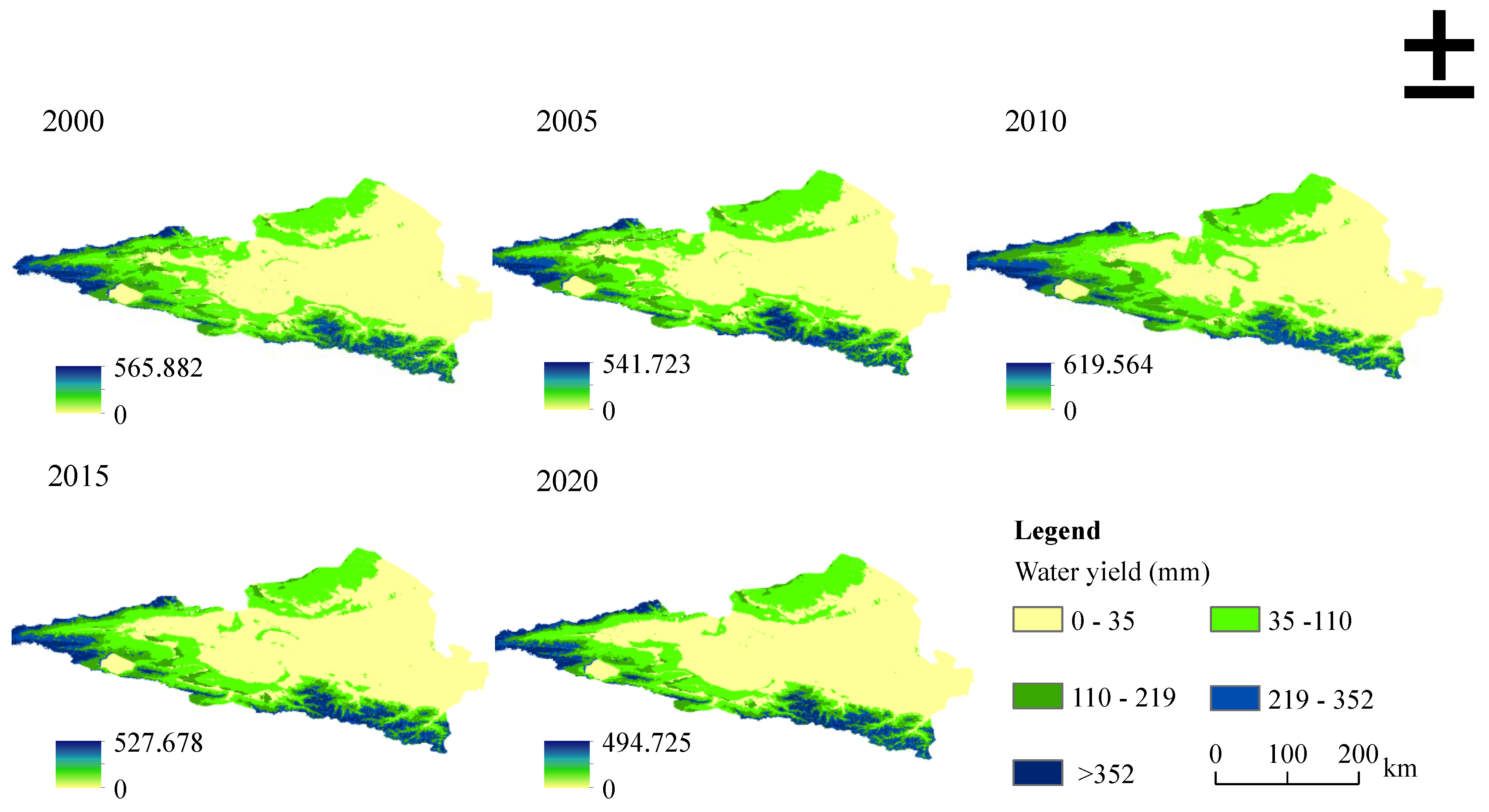
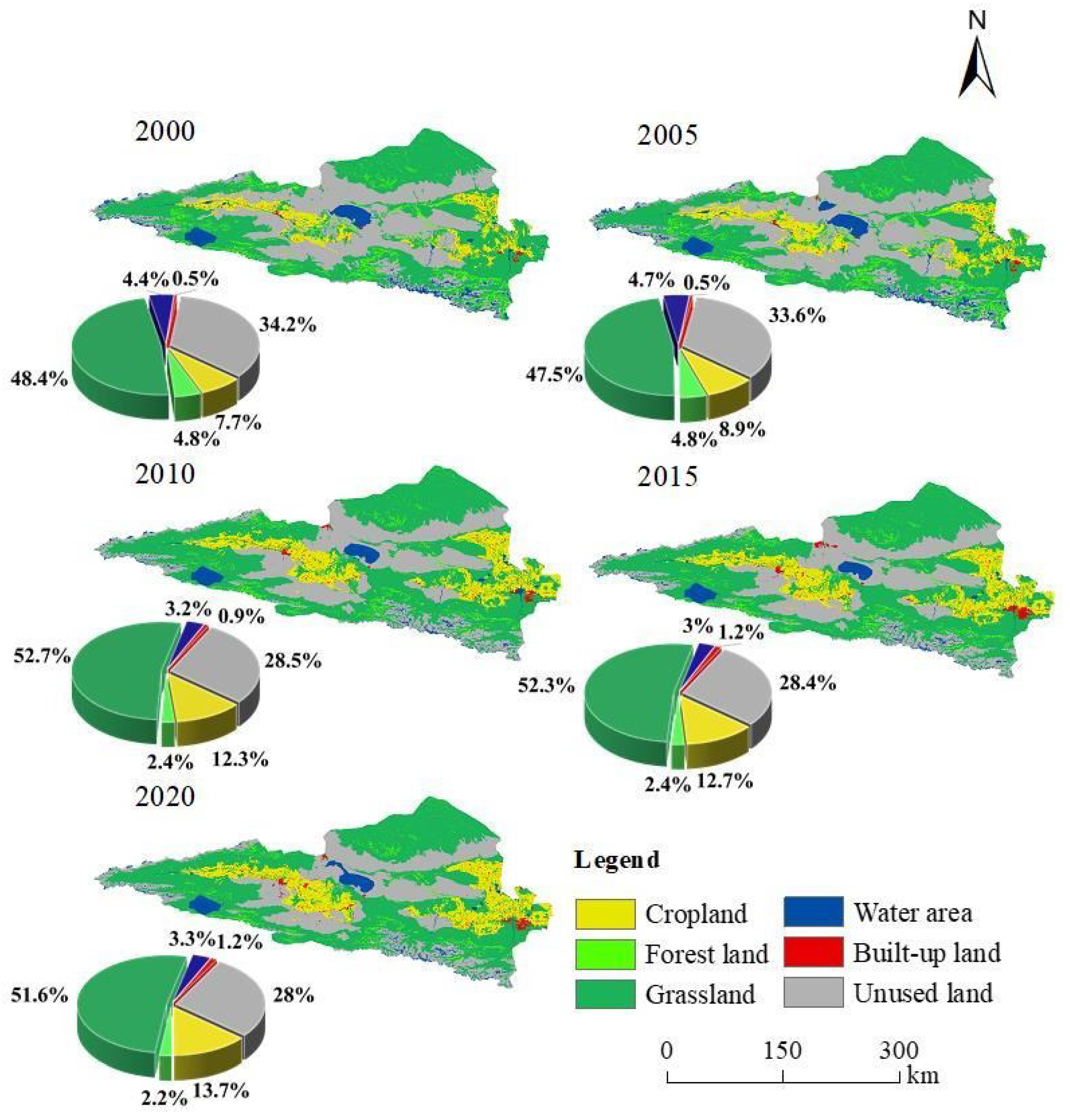
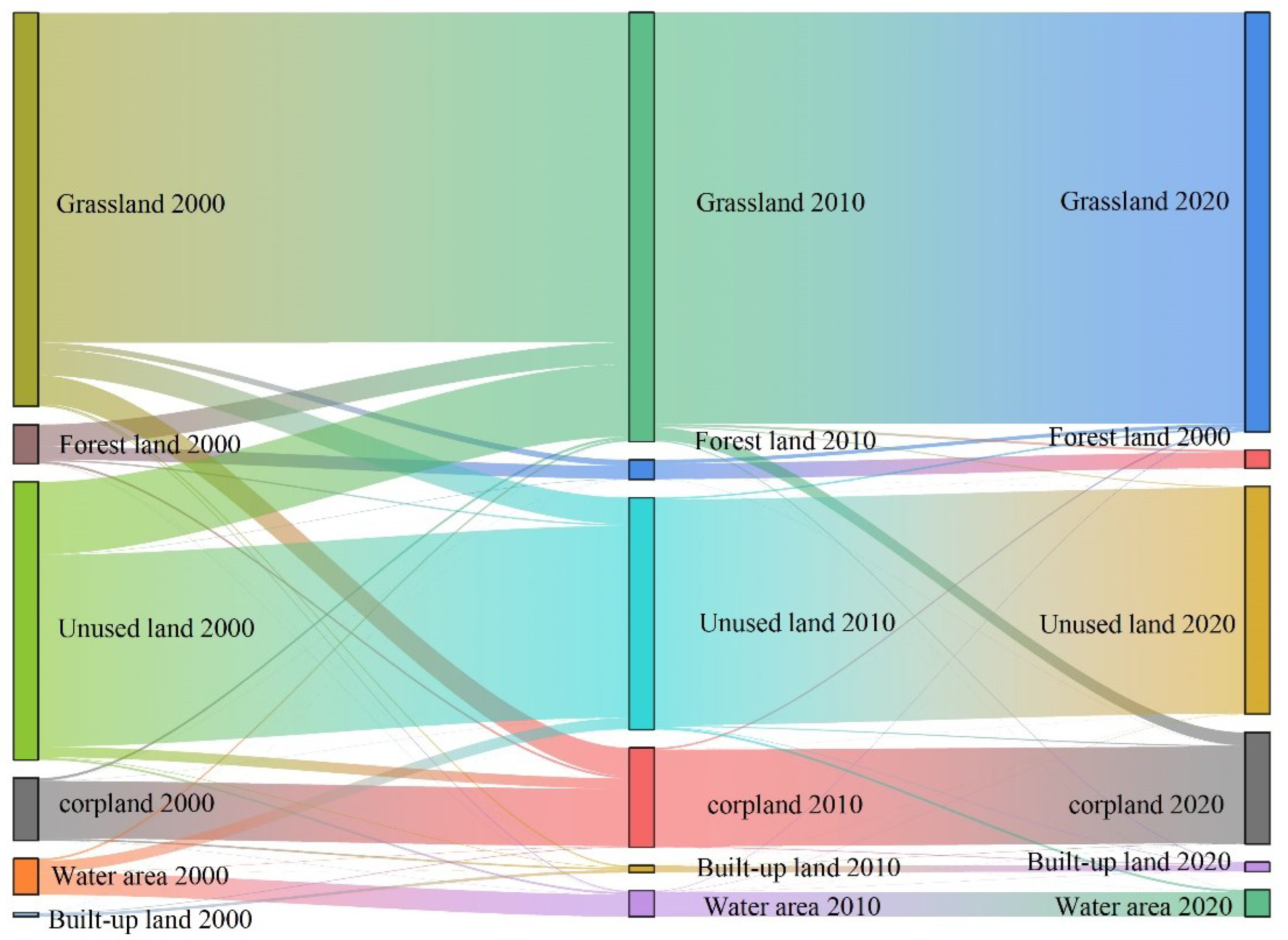

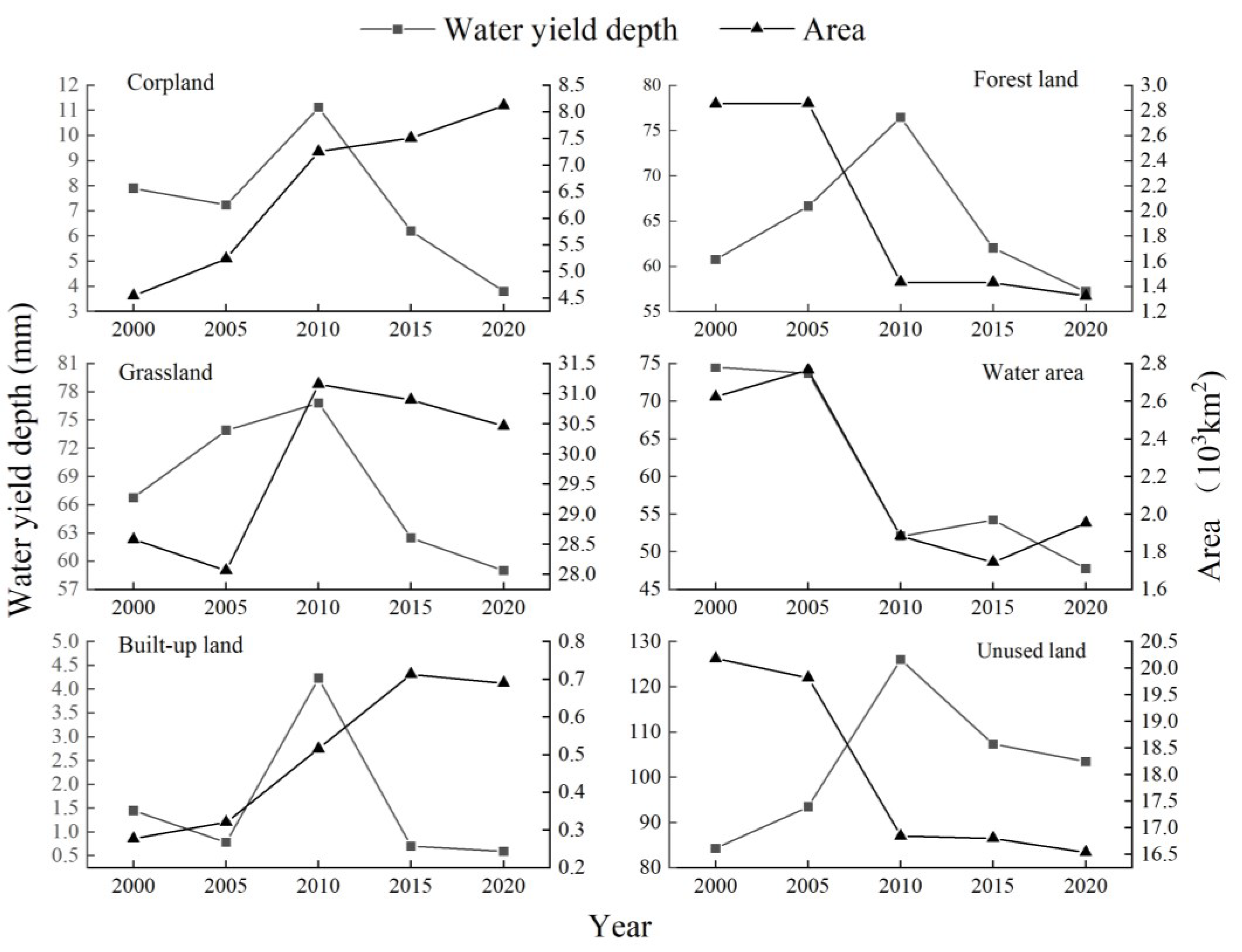
| Land Use | Root Depth (mm) | KC |
|---|---|---|
| Cropland | 2200 | 0.8 |
| Forest land | 5400 | 1 |
| Grassland | 2800 | 0.7 |
| Water area | 100 | 1 |
| Built-up land | 100 | 0.3 |
| Unused land | 400 | 0.1 |
| Data | Data Type and Resolution | Data Source |
|---|---|---|
| Precipitation | Raster 1000 m × 1000 m | Nature Earth System Science Data Center (http://www.geodata.cn, accessed on 16 June 2024) |
| Reference Evapotranspiration | Raster 1000 m × 1000 m | Nature Earth System Science Data Center (http://www.geodata.cn, accessed on 16 June 2024) |
| World Soil Database | Raster 1000 m × 1000 m | National Cryosphere Desert Science Data Center (https://www.crensed.ac.cn, accessed on 20 June 2024) |
| Plant Available Water Fraction | Raster 1000 m × 1000 m | Nature Earth System Science Data Center (http://www.geodata.cn, accessed on 20 June 2024) |
| LUCC | Raster 30 m × 30 m | Resource and Environmental Science Data Platform) (http://www.geodata.cn, accessed on 10 May 2024) |
| Region | Type of Variance | Levene’s Test for Equality of Variances | t-Test for Equality of Means | |||
|---|---|---|---|---|---|---|
| F | Sig (P) | t | Df | Sig (P) (Two-Tailed) | ||
| Karamay | Equal variance assumed | 3.028 | 0.12 | 0.944 | 8 | 0.373 |
| Equal variance not assumed | 0.944 | 5.723 | 0.383 | |||
| Bortala | Equal variance assumed | 0.697 | 0.428 | 1.069 | 8 | 0.316 |
| Equal variance not assumed | 1.069 | 6.356 | 0.324 | |||
| Ili valley | Equal variance assumed | 2.909 | 0.126 | 1.398 | 8 | 0.200 |
| Equal variance not assumed | 1.398 | 7.193 | 0.204 | |||
| Tacheng | Equal variance assumed | 0.09 | 0.772 | −1.553 | 8 | 0.159 |
| Equal variance not assumed | −1.553 | 7.989 | 0.159 | |||
| Actual Situation | Climate Change Scenarios | Land Use Change Scenarios | |||||||
|---|---|---|---|---|---|---|---|---|---|
| 2000 | 2010 | 2020 | S1 | S2 | S3 | S4 | S5 | S6 | |
| Climate | 2000 | 2010 | 2020 | 2020 | 2010 | 2020 | 2000 | 2000 | 2010 |
| LUCC | 2000 | 2010 | 2020 | 2000 | 2000 | 2010 | 2020 | 2010 | 2020 |
| Land Use Area/km2 | 2020 | Area of Transfer Out | |||||
|---|---|---|---|---|---|---|---|
| 2000 | Cropland | Forest Land | Grassland | Water Area | Built-Up Land | Unused Land | |
| Cropland | 9.83 | 161.17 | 13.20 | 175.38 | 7.26 | 366.84 | |
| Forest land | 208.20 | 1625.89 | 19.79 | 8.54 | 116.31 | 1978.73 | |
| Grassland | 2544.23 | 397.77 | 47.37 | 189.08 | 1912.06 | 5090.51 | |
| Water area | 37.17 | 3.67 | 168.89 | 9.04 | 815.70 | 1034.47 | |
| Built-up land | 56.88 | 0.50 | 5.78 | 0.46 | 3.91 | 67.53 | |
| Unused land | 1090.99 | 37.17 | 5008.74 | 283.00 | 98.37 | 6518.28 | |
| Area of transfer in | 3937.46 | 448.93 | 6970.48 | 363.83 | 480.41 | 2855.24 | 15,056.35 |
| Year | LUCC | Land Use | Water Yield | Water Yield Depth (mm) (Yield per Unit Area) | ||
|---|---|---|---|---|---|---|
| Area (km2) | Pct (%) | Yearly Output (108 m3) | Pet (%) | |||
| 2000 | Cropland | 4547.38 | 7.70 | 0.36 | 0.90 | 7.90 |
| Forest land | 2853.13 | 4.83 | 1.75 | 4.39 | 60.73 | |
| Grassland | 28,580.65 | 48.39 | 19.01 | 47.82 | 66.76 | |
| Water area | 2624.36 | 4.44 | 1.89 | 4.78 | 74.50 | |
| Built-up land | 277.77 | 0.47 | 0.004 | 0.01 | 1.45 | |
| Unused land | 20,186.09 | 34.17 | 16.71 | 42.08 | 84.28 | |
| 2005 | Cropland | 5243.65 | 8.88 | 0.38 | 0.88 | 7.23 |
| Forest land | 2856.51 | 4.84 | 1.91 | 4.45 | 66.65 | |
| Grassland | 28,064.35 | 55.06 | 20.65 | 47.87 | 73.91 | |
| Water area | 2768.38 | 5.43 | 1.98 | 4.60 | 73.72 | |
| Built-up land | 321.38 | 0.63 | 0.002 | 0.01 | 0.78 | |
| Unused land | 19,819.82 | 38.88 | 18.2 | 42.19 | 93.47 | |
| 2010 | Cropland | 7253.13 | 12.27 | 0.81 | 1.69 | 11.12 |
| Forest land | 1434.26 | 2.42 | 1.17 | 2.35 | 76.46 | |
| Grassland | 31,161.71 | 52.73 | 23.84 | 50.22 | 76.80 | |
| Water area | 1883.15 | 3.18 | 0.95 | 2.01 | 52.07 | |
| Built-up land | 516.46 | 0.87 | 0.02 | 0.01 | 4.23 | |
| Unused land | 16,847.82 | 28.51 | 20.75 | 43.71 | 126.04 | |
| 2015 | Cropland | 7508.03 | 12.71 | 0.47 | 1.19 | 6.21 |
| Forest land | 1429.05 | 2.42 | 0.90 | 2.30 | 62.01 | |
| Grassland | 30,895.34 | 52.28 | 19.23 | 49.12 | 62.49 | |
| Water area | 1745.60 | 2.95 | 0.91 | 2.34 | 54.24 | |
| Built-up land | 713.55 | 1.21 | 0.005 | 0.01 | 0.71 | |
| Unused land | 16,802.68 | 28.43 | 17.63 | 45.02 | 107.34 | |
| 2020 | Cropland | 7508.03 | 12.71 | 0.31 | 0.83 | 3.79 |
| Forest land | 1429.05 | 2.42 | 0.77 | 2.09 | 57.18 | |
| Grassland | 30,895.34 | 52.28 | 17.92 | 48.60 | 59.01 | |
| Water area | 1745.60 | 2.95 | 0.92 | 2.50 | 47.78 | |
| Built-up land | 713.55 | 1.21 | 0.004 | 0.01 | 0.59 | |
| Unused land | 16,802.68 | 28.43 | 16.95 | 45.96 | 103.50 | |
| LUCC | Actual Conditions | Climate Change | Land Use Change | ||||||
|---|---|---|---|---|---|---|---|---|---|
| 2000 | 2010 | 2020 | S1 | S2 | S3 | S4 | S5 | S6 | |
| Cropland | 0.36 | 0.81 | 0.31 | 0.22 | 0.62 | 0.29 | 0.49 | 0.46 | 0.86 |
| Forest land | 1.75 | 1.16 | 0.77 | 1.60 | 2.03 | 0.85 | 0.81 | 0.90 | 1.00 |
| Grassland | 19.00 | 23.84 | 17.92 | 17.60 | 23.11 | 17.84 | 19.43 | 19.36 | 23.19 |
| Water area | 1.89 | 0.95 | 0.92 | 1.72 | 1.89 | 0.93 | 0.95 | 0.95 | 0.95 |
| Built-up land | 0.00 | 0.02 | 0.00 | 0.00 | 0.02 | 0.00 | 0.01 | 0.01 | 0.03 |
| Unused land | 16.72 | 20.75 | 16.95 | 15.72 | 21.18 | 17.01 | 17.57 | 17.66 | 20.57 |
| Total | 40.11 | 47.93 | 37.05 | 36.87 | 48.84 | 36.91 | 39.26 | 39.34 | 47.33 |
Disclaimer/Publisher’s Note: The statements, opinions and data contained in all publications are solely those of the individual author(s) and contributor(s) and not of MDPI and/or the editor(s). MDPI and/or the editor(s) disclaim responsibility for any injury to people or property resulting from any ideas, methods, instructions or products referred to in the content. |
© 2024 by the authors. Licensee MDPI, Basel, Switzerland. This article is an open access article distributed under the terms and conditions of the Creative Commons Attribution (CC BY) license (https://creativecommons.org/licenses/by/4.0/).
Share and Cite
Yang, X.; Gu, X.; Zhang, P.; Liu, J.; Zhang, W.; Long, A. Assessment of the Impacts of Climate and Land Use Changes on Water Yield in the Ebinur Lake Basin. Land 2024, 13, 1324. https://doi.org/10.3390/land13081324
Yang X, Gu X, Zhang P, Liu J, Zhang W, Long A. Assessment of the Impacts of Climate and Land Use Changes on Water Yield in the Ebinur Lake Basin. Land. 2024; 13(8):1324. https://doi.org/10.3390/land13081324
Chicago/Turabian StyleYang, Xinxin, Xinchen Gu, Pei Zhang, Jing Liu, Wenjia Zhang, and Aihua Long. 2024. "Assessment of the Impacts of Climate and Land Use Changes on Water Yield in the Ebinur Lake Basin" Land 13, no. 8: 1324. https://doi.org/10.3390/land13081324





